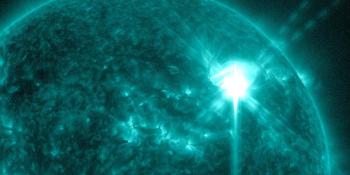Viendo archivo del martes, 4 septiembre 2012
Informe actividad solar
Any mentioned solar flare in this report has a scaling factor applied by the Space Weather Prediction Center (SWPC). Because of the SWPC scaling factor, solar flares are reported as 42% smaller than for the science quality data. The scaling factor has been removed from our archived solar flare data to reflect the true physical units.
Informe de actividad Solar-Geofísica 2012 Sep 04 2200 UTCPreparado por NOAA © SWPC y procesado por SpaceWeatherLive.com
Informe conjunto USAF/NOAA de actividad Solar y Geofísica
SDF Número 248 Publicado el 2200Z a las 04 Sep 2012IA. Análisis de regiones solares activas y de actividad desde 03-2100Z hasta 04-2100Z Solar activity was low. Region 1564 (S14E14 -
Esi/beta-gamma) was the most active region, producing occasional
low-level C-class flares. It increased in spot count and area during
the first half of the period, but showed gradual spot and penumbral
decay during the latter half of the period. Region 1560 (N04W47 -
Eai/beta-gamma-delta) showed a slight decrease in spots and area,
but maintained a delta in its interior spots. No significant changes
were observed in the remaining spotted regions and no new regions
were numbered. No Earth-directed CME activity was observed during
the period.
IB. Pronóstico de la actividad solar
Solar activity is expected to be low
through the period (05 - 07 September) with a chance for an isolated
M-class flare.
IIA. Resumen de la actividad geofísica 03-2100Z a 04-2100Z
Geomagnetic field activity ranged from quiet to minor storm levels
with major storm periods detected at high latitudes, all due to
residual CME effects. The greater than 10 MeV proton event at
geosynchronous orbit that began at 01/1335Z, reached a maximum of 59
pfu at 02/0850Z, and ended at 04/0625Z.
IIB. Pronóstico de la actividad geofísica
Geomagnetic field activity is
expected to be at quiet to unsettled levels during days 1 - 2 (05 -
06 September) with a chance for active levels. This is due to the
arrival of CMEs observed on 02 September along with a co-rotating
interaction region in advance of a coronal hole high-speed stream
(CH HSS). The CMEs are expected to arrive around midday on day 1.
The CH HSS is expected to commence on day 2. Field activity is
expected to be at quiet to unsettled levels on day 3 (07 September)
as CH HSS effects subside.
III. Probabilidades del evento 05 Sep a 07 Sep
| Clase M | 25% | 25% | 25% |
| Clase X | 01% | 01% | 01% |
| Protón | 01% | 01% | 01% |
| PCAF | green | ||
IV. Penticton 10.7cm flujo
Observado 04 Sep 138 Previsto 05 Sep-07 Sep 135/135/130 Media de 90 Días 04 Sep 124
V. Índices Geomagnéticos A
Observado Afr/Ap 03 Sep 023/040 Estimado Afr/Ap 04 Sep 012/014 Previsto Afr/Ap 05 Sep-07 Sep 010/012-010/010-007/008
VI. Probabilidades de Actividad Geomagnética 05 Sep a 07 Sep
| A. Latitudes Medias | |||
|---|---|---|---|
| Activo | 20% | 15% | 15% |
| Tormenta Menor | 05% | 05% | 01% |
| Tormenta Mayor-Severa | 01% | 01% | 01% |
| B. Latitudes Altas | |||
|---|---|---|---|
| Activo | 15% | 15% | 15% |
| Tormenta Menor | 30% | 20% | 25% |
| Tormenta Mayor-Severa | 30% | 25% | 20% |
< < Ir a la visión general diaria
Últimas noticias
Últimos mensajes del foro
AR3663 245Sporadic E and Flare activity 22AR3664 90Incoming Active Regions 238Filaments and prominences 79
Más temasApoye a SpaceWeatherLive.com!
Mucha gente viene a SpaceWeatherLive para seguir la actividad del Sol o previsión de aurora, pero con esta cantidad de tráfico se incrementan los costos del servidor. ¡Considere hacer una donación si disfruta de SpaceWeatherLive para que podamos mantener el sitio web en línea!

Hechos clima espacial
| Último evento clase X | 2024/05/06 | X4.52 |
| Último evento clase M | 2024/05/07 | M3.2 |
| Últimas tormentas geomagnéticas | 2024/05/06 | Kp5 (G1) |
| Días sin manchas | |
|---|---|
| Último día sin manchas | 2022/06/08 |
| Promedio de manchas solares mensuales | |
|---|---|
| abril 2024 | 136.5 +31.6 |
| Last 30 days | 161.9 +69.9 |


